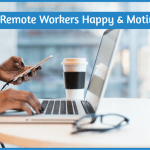
How To Support Employees Who Suffer With Migraines
It can be hard to support employees who suffer from migraines if you’ve never had one yourself.
You may not know that much about them, or you may believe one of the many common misconceptions about migraines. You might even think that a migraine is just another name for a really bad headache, as so many people do.
However, for millions of sufferers across the world — including some of your employees — migraines are painful, distressing and life-altering.
That’s why it’s so important to be able to appropriately support employees who suffer from migraines.
In this article, we’ll cover the basics of what you need to know about this common condition, as well as the steps you can take as a HR department or an employer to ensure that your team is supported and looked after.
Here is what you can do to support employees who suffer from migraines:
Learn more about what a migraine is
As we’ve already mentioned, there are lots of misconceptions about migraines, which most people tend to view as bad headaches. In fact, according to a recent survey, fewer than a quarter of bosses consider having a migraine as an adequate reason for calling in sick to work.
One of the first things you can do is to further your own understanding of migraines so that you can create policies and a work environment that adequately answers the needs of your staff.
Migraine is an extremely common neurological condition that affects 39 million people in the US alone — and one billion worldwide.
It is characterized by severe, intense and recurring throbbing pain, usually on one side of the head (though sometimes on both), as well as dizziness, nausea, and heightened sensitivity to light, sound and smell. Sufferers may also experience tingling and numbness, as well as seeing flashing lights just before an attack begins.
You can easily find out more about migraines online, so read up about this disease to help guide your sickness policies so that they are migraine-inclusive.
Be aware of how their symptoms may present
Everyone experiences migraines differently, so don’t expect any two of your employees to have exactly the same experiences with their condition.
Migraines vary hugely between individuals. Some migraine sufferers may only have mild, shorter attacks. Others can experience severe and debilitating migraine attacks that last for days.
The effectiveness of treatments will depend on the individual too — most people find sleep or lying in a dark room helps, but lots of sufferers also need painkillers to reduce their symptoms. Sometimes over-the-counter painkillers like aspirin can help, but for some, stronger prescription medication is needed, like Sumatriptan (you can read sumatriptan reviews and ratings here to understand how it works).
Frequency can also vary. Some people may only have migraines occasionally, with even years passing between attacks; others can have migraines frequently, up to several times a week.
As an employer or HR team, don’t assume that you know what your employees are experiencing — speak to them to get a better understanding.
Create a comfortable work environment
As an employer, you can really help employees who suffer from migraines by minimizing migraine triggers.
Creating a comfortable work environment that will accommodate any team members with migraines will also help to reduce sick leave due to the condition, and increase productivity.
There are a few ways you can do this:
- Firstly, reduce brightness — which can make migraines worse — by avoiding the use of bright lights, reducing glare from light/white walls, and by installing window blinds if necessary.
- If your employees use computers, invest in screen glare screens, as well as encouraging them to download a screen brightness app that reduces harsh light and brightness.
- Increased sound sensitivity can be a migraine symptom, so tackle this by managing sound in the workplace — for example, by providing noise-canceling headsets, installing sound absorption panels, and creating quiet breakout spaces.
- Ensure that your workspace is well-ventilated to improve symptoms like nausea, dizziness, and a heightened sense of smell.
These are just a few of the things you can do to accommodate employees who suffer with migraines in the workplace. They’re all relatively easy to achieve, and they can provide some comfort and support to migraine sufferers while they’re at work.
And remember, if in doubt, you can always ask employees who suffer from migraines what they think will help, and what they need — it’ll provide you with valuable insight.
Encourage and prioritize wellbeing at work
Prioritizing wellbeing at work is important for a number of reasons.
From a business perspective, companies that prioritize employee engagement and wellbeing outperform those that don’t by 10%. Supporting your staff increases productivity, profit, morale, loyalty, and more — benefiting your business across the board.
And of course, it hugely benefits your employees too, improving individual happiness, wellbeing, and fulfilment in the workplace. Particularly for those who suffer from health conditions like migraines, prioritizing wellbeing is crucial.
Start with the basics (if you haven’t already) by ensuring that employees take adequate breaks during the day, and take time away from their desk for lunch. Likewise, ensure that your team stays hydrated by installing a water cooler in your office and making sure everyone drinks enough, particularly in hot weather.
Next, do a deep-dive into individual wellbeing and find out how you could improve the work lives of your employers. Speak to those who suffer from migraines about what would make their work experience better, and what would help to reduce the risk of migraines or improve symptoms at work.
Work on an action plan together with your employee to come up with reasonable solutions and adjustments. Does stress trigger their migraines? If there’s a way to lighten their workload and stress, then do it. If a dark, quiet room would help during attacks, see if you can provide one.
Flexible and remote working is also hugely beneficial for employees with migraines, helping them to work around attacks and rest up when they’re really suffering.
If you don’t know much about migraines, then you may not know how to support employees who suffer from the condition. By following the advice above, you can ensure that your team is supported and looked after in the workplace, and that you can navigate your way around migraines together.
© New To HR


